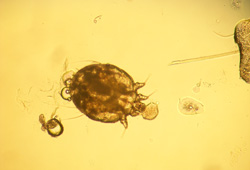Resumo
Definição
História e exame físico
Principais fatores diagnósticos
- lactentes, crianças e idosos
- história de superlotação
- história de prurido em membros familiares ou contatos próximos no mesmo período
- prurido generalizado e intenso, tipicamente com piora à noite
- escavações
- pápulas, vesículas, escoriações
- teste de tinta na escavação positivo
Outros fatores diagnósticos
- pápulas na face, pescoço, palmas das mãos e solas dos pés em crianças
- imunossupressão
- bolhas
- lesões espessas e crostosas que ocorrem nos cotovelos, joelhos, mãos e pés, com unhas distróficas
- nódulos
Fatores de risco
- condições de superlotação/pobreza
- morar em alojamentos próximos com outras pessoas infectadas
- idade abaixo de 15 anos ou acima de 65 anos
- contato sexual com parceiros novos ou múltiplos
- imunossupressão
- higiene precária
- contato com um animal infectado
- contato com roupas, toalhas e cama contaminadas
- estação do inverno
Investigações diagnósticas
Primeiras investigações a serem solicitadas
- preparação do ectoparasita
Investigações a serem consideradas
- biópsia de pele
Novos exames
- microscopia óptica por epiluminescência
Algoritmo de tratamento
adultos não gestantes/não lactantes ou crianças acima dos 5 anos de idade
bebês e crianças de 2 meses a 5 anos de idade e gestantes ou lactantes
lactentes com menos de 2 meses de idade
Colaboradores
Autores
Ryan Harris, MD
Dermatologist
Treasure Valley Dermatology and Skin Cancer Center
Boise
ID
Declarações
RH declares that he has no competing interests.
Agradecimentos
Dr Ryan Harris would like to gratefully acknowledge Dr Pooja Khera and Dr Laura Korb Ferris, previous contributors to this topic.
Declarações
PK and LKF declare that they have no competing interests.
Revisores
David Cassarino, MD, PhD
Assistant Professor
Department of Pathology and Laboratory Medicine
University of California
Los Angeles
CA
Declarações
DC declares that he has no competing interests.
Roderick J. Hay, DM, FRCP, FRCPath, FMedSci
Chairman
International Foundation of Dermatology
London
UK
Declarações
RJH declares that he has no competing interests.
Créditos aos pareceristas
Os tópicos do BMJ Best Practice são constantemente atualizados, seguindo os desenvolvimentos das evidências e das diretrizes. Os pareceristas aqui listados revisaram o conteúdo pelo menos uma vez durante a história do tópico.
Declarações
As afiliações e declarações dos pareceristas referem--se ao momento da revisão.
Referências
Principais artigos
Chosidow O. Clinical practices. Scabies. N Engl J Med. 2006 Apr 20;354(16):1718-27. Resumo
Heukelbach J, Feldmeier H. Scabies. Lancet. 2006 May 27;367(9524):1767-74. Resumo
Hengge UR, Currie BJ, Jager G, et al. Scabies: a ubiquitous neglected skin disease. Lancet Infect Dis. 2006 Dec;6(12):769-79. Resumo
Strong M, Johnstone PW. Interventions for treating scabies. Cochrane Database Syst Rev. 2007 Jul 18;(3):CD000320.Texto completo Resumo
Rosumeck S, Nast A, Dressler C. Ivermectin and permethrin for treating scabies. Cochrane Database Syst Rev. 2018 Apr 2;(4):CD012994.Texto completo Resumo
Johnstone P, Strong M. Scabies. Clin Evid. 2006 Jun;(15):2284-90. Resumo
Artigos de referência
Uma lista completa das fontes referenciadas neste tópico está disponível para os usuários com acesso total ao BMJ Best Practice.

Diagnósticos diferenciais
- Impetigo
- Dermatite xerótica
- Foliculite
Mais Diagnósticos diferenciaisDiretrizes
- Sexually transmitted infections treatment guidelines, 2021: ectoparasitic infections
- European guideline for the management of scabies
Mais DiretrizesFolhetos informativos para os pacientes
Escabiose
Mais Folhetos informativos para os pacientesConectar-se ou assinar para acessar todo o BMJ Best Practice
O uso deste conteúdo está sujeito ao nosso aviso legal